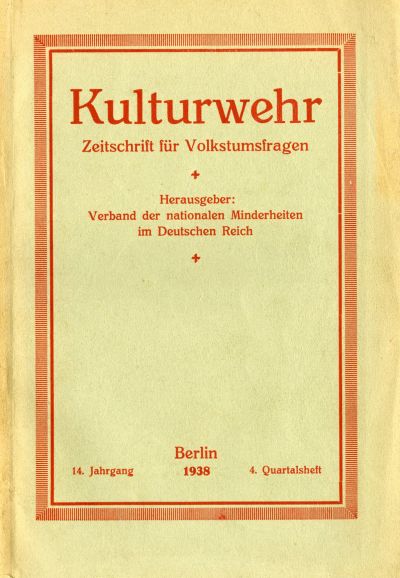Dziennik Berliński

The editorial team changed a few times due to financial problems. This meant that the political profile of the “Dziennik” also changed. It’s boom years (over 3,000 subscribers) were between 1915 and 1919. But after the huge wave of emigration back to the “reborn” country of Poland the newspaper was faced with extinction. It was only saved when it was bought up by a Warsaw cooperative financed by the Polish government. But its financial difficulties were far from solved: by contrast they grew worse thanks to inflation and the negative policies of the German government towards Polish people (in 1921 sales of the paper were banned in railway stations, there were attacks in the German press, editors were arrested on the alleged grounds that they were responsible for slandering German civil servants). In 1921 the newspaper was forced to sell its buildings and printing press; and in 1922 publication stopped for a short period. In 1925 its print shop was moved the “Katolik” printing house in Bytom, before moving once again in 1932 to Opole, and later to Herne, all of which made reporting very difficult. In 1927 the circulation amounted to 2,200, an amount insufficient to retain any financial stability. The paper tried to attract new readership amongst seasonal agricultural workers and by printing supplements on special themes. After the Nazis came to power in 1933 the German state increased its newspaper censorship and even confiscated complete editions. Despite the huge number of problems it faced the newspaper managed to survive until September 1939.
The first attempts to publish a journal for Polish people in the Berlin area were made around the end of the 19th century. Similar attempts had been made earlier, but due to the shortage of capital under Polish immigrants and the lack of wealthy sponsors it was impossible to realise this dream for many years. However the problem was solved in 1897 thanks to well-known and highly respected emigrants from Poland like Władysław Berkan and Pastor Piotr Wawrzyniak. The “Dziennik Berliński” (initially: “Dziennik Polski”) began publication. From the very start the newspaper’s main aim was to maintain the feelings of Polish people for their nation, their language and their religion. Up until the First World War the newspaper had a number of different editors and this affected its political policies. Paradoxically the newspaper experienced its boom years during the First World War and the years immediately afterwards. Between 1915 and 1919 it had roughly 3,000 subscribers. After 1918, following the mass emigration of Polish citizens back to the Second Polish Republic, the newspaper was threatened with extinction. But after the Union of Poles in Germany was set up people began to organise the Polish press and encourage reporters and editors to co-operate with the new organisation. That said, the Union could not afford to set up its own newspaper and an improved cooperation with the already existing organs of the press proved an equally great challenge.
At the invitation of the Union of Poles the first joint discussions took place on the 21st and 22nd of April 1923, to which all representatives of the Polish press were invited. Soon people began to describe this meeting as “the first gathering of the Polish press in Germany”. On the opening day the “Dziennik“ published an article entitled “The Press and Society” which underlined the fact that the Polish press as a whole regarded it as a duty to provide information. “It should have a cultural and educational influence, and also a Polish national influence. Despite its many different names it should be a common mouthpiece whose basic duty is to maintain and develop national consciousness amongst Polish citizens”. However the meeting failed to solve the problems of the press for the Polish minority and the newspaper continued to suffer from the loss of editors and the decline in subscribers due to unemployment and inflation.
To prevent the closure of the “Dziennik Berliński” the central committee of the Union of Poles decided in August 1923 to reduce the number of editions to three per week. Other Polish journals published in Berlin also helped to save the newspaper and the Union of Poles made it compulsory for its members to take out subscriptions. The Polish Embassy in Berlin also rushed to its aid, as did the Society to Protect the Westmark (Związek Obrony Kresów Zachodnich). By 1924 the newspaper was back on a more stable level and again began to appear every day. The number of subscriptions grew to over 2,000. Its editor-in-chief was Czesław Tabernacki until the newspaper closed in 1939. In order to reduce the costs of publication and ensure that the newspaper could be regularly printed he moved the print house to the “Katolik” printing press in Bytom, then to the “Nowiny Codzienne” printing press in Opole, and finally to the “Naród” print house“ in Herne. During this time the editors remained in Berlin. An important event in the history of the Polish press in Germany was the foundation of a press headquarters at the Union of Poles in Germany on 10th January 1927. The first head was Tadeusz Katelbach and he was succeeded in 1934 by Edmund Osmańczyk.
![Dziennik Berliński [Berlin Journal] - radio play in German Dziennik Berliński [Berlin Journal] - radio play in German - In co-operation with ‘COSMO Radio po polsku’ we present radio plays on selected topics of our portal.](/themes/porta_polonica/assets/images/audio.jpg)


